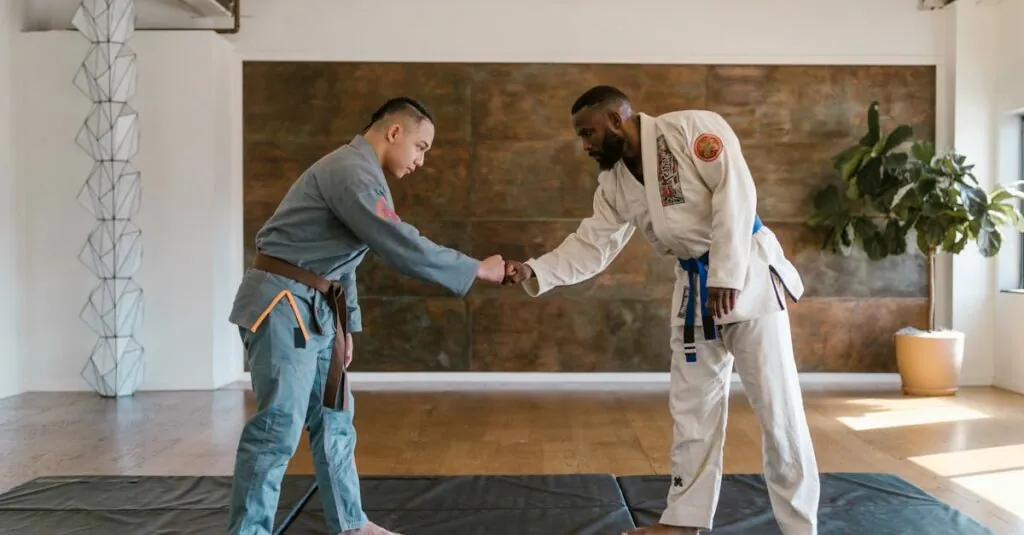Table of Contents
ToggleIn a world where discipline often gets a bad rap, mutual respect discipline emerges as the superhero we didn’t know we needed. Imagine a classroom or workplace where everyone feels valued and heard, yet still knows how to keep things on track. Sounds like a dream, right? Well, it doesn’t have to be. This approach fosters an environment where rules are respected and relationships thrive, proving that discipline doesn’t have to be a dirty word.
Mutual respect discipline isn’t just about enforcing rules; it’s about creating a culture of understanding and cooperation. Picture this: instead of shouting orders, leaders and educators engage in open dialogue, making everyone feel like they’re part of the solution. It’s not just effective; it’s downright revolutionary. So buckle up and get ready to explore how this game-changing approach can transform your interactions and lead to a more harmonious environment.
Understanding Mutual Respect Discipline
Mutual respect discipline fosters an environment where individuals feel recognized and valued. This approach stands out by prioritizing dialogue over authoritative control.
Definition and Importance
Mutual respect discipline defines a framework focused on open communication and collaboration. It plays a critical role in maintaining order while empowering participants to express their thoughts. This strategy goes beyond traditional methods, which often rely on power dynamics. By valuing each individual’s perspective, the process contributes to higher engagement levels. Participants feel more invested, leading to positive behavior that strengthens community bonds. Emphasizing respect creates a supportive atmosphere that enhances overall interactions.
Key Principles of Mutual Respect Discipline
Key principles guide the implementation of mutual respect discipline. First, fostering open communication allows participants to engage freely. Second, setting clear expectations ensures everyone understands their responsibilities. Third, modeling respectful behavior encourages others to follow suit. Fourth, practice active listening fosters a culture of understanding and validation. Additionally, providing constructive feedback focuses on growth rather than punishment. When these principles are upheld, the environment shifts towards collaboration, benefiting all involved. These foundational elements drive a significant transformation in behavior and relationships.
Benefits of Mutual Respect Discipline
Mutual respect discipline offers numerous advantages that enhance interaction and behavior in classrooms and workplaces. This approach nurtures a supportive environment, leading to stronger connections among participants.
Enhancing Relationships
Enhancing relationships becomes a primary outcome of mutual respect discipline. Open communication encourages trust, enabling individuals to share thoughts without fear of judgment. As trust builds, collaboration increases, making it easier for team members to support one another. Participants often feel seen and respected, which strengthens community ties. A sense of belonging fosters unity, making the environment more inclusive. This inclusivity contributes to improved understanding among peers, leading to more effective cooperation in various tasks.
Promoting Positive Behavior
Promoting positive behavior emerges from the consistent practice of mutual respect discipline. Expectations are clear, guiding individuals towards appropriate conduct. When respect becomes a norm, participants are more likely to engage in constructive dialogue, addressing conflicts peacefully. In this environment, individuals feel empowered to express concerns without escalating tensions. Positive reinforcement helps maintain this behavior, encouraging everyone to model the respectful conduct established. Participants experience increased motivation to contribute positively, resulting in a more harmonious atmosphere conducive to learning and collaboration.
Implementing Mutual Respect Discipline
Implementing mutual respect discipline requires intentional strategies for both parents and educators. Each role contributes significantly to creating a supportive environment.
Strategies for Parents
Parents can model respectful communication at home. By actively listening to children, they demonstrate the value of understanding different perspectives. Setting clear family expectations about behavior fosters accountability. Reinforcement through positive feedback encourages children to practice respectful interactions with siblings and peers. Participation in family discussions allows children to express their feelings, promoting a sense of ownership. When parents exhibit trust and respect, children mirror these behaviors in their relationships.
Approaches for Educators
Educators play a crucial role in implementing mutual respect discipline in classrooms. Establishing clear rules and consequences at the outset sets a respectful tone. Engaging students in discussions about classroom culture encourages ownership of their behavior. Active listening during conflicts helps students feel heard, reducing tension and fostering cooperation. Celebrating respectful behavior through recognition motivates students to follow suit. Consistently modeling respect in interactions creates a strong foundation for positive behavior and collaboration.
Challenges in Practicing Mutual Respect Discipline
Practicing mutual respect discipline presents challenges that require acknowledgment and proactive strategies to address them.
Common Misconceptions
Many people mistakenly believe that mutual respect discipline only involves being permissive. This assumption oversimplifies the approach, which combines guidance with collaboration. Others think that respect is automatically understood, neglecting the need for explicit discussions about its importance. Furthermore, some individuals view this discipline as weak or ineffective compared to traditional authoritative methods. Such beliefs overlook the actual benefits that mutual respect fosters, including stronger community bonds and improved behaviors. Clarity in communication and consistent reinforcement of expectations are crucial to dispel these myths and ensure everyone understands their role.
Overcoming Resistance
Resistance often arises when individuals perceive mutual respect discipline as a challenge to established norms. Shifts in mindset take time, and consistent efforts are necessary to facilitate acceptance. Engaging participants in dialogue about the approach can ease concerns and build trust. Offering workshops or training sessions helps participants articulate their reservations while learning key principles. Demonstrating the approach’s effectiveness through real examples reinforces its value. When participants experience positive outcomes, they become more likely to embrace this discipline method. Ultimately, persistence in these strategies fosters an environment of mutual respect where collaboration thrives.
Conclusion
Mutual respect discipline stands as a transformative approach that reshapes interactions in both classrooms and workplaces. By prioritizing open communication and collaboration, it cultivates an environment where everyone feels valued. This method not only enhances relationships but also encourages positive behavior, creating a sense of belonging among participants.
As individuals practice mutual respect, they contribute to a culture that emphasizes understanding and cooperation. The principles guiding this approach empower individuals to engage meaningfully, addressing conflicts with respect and fostering a harmonious atmosphere. With consistent effort and clear expectations, mutual respect discipline can lead to lasting positive change, benefiting all involved. Embracing this strategy paves the way for stronger community bonds and a more engaged, respectful environment.







